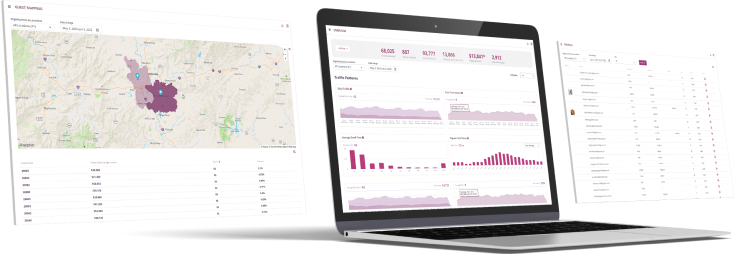In the world of restaurants, where competition is as varied and rich as the menus, understanding and utilizing guest data can be the secret ingredient to success.
As a restaurant owner or marketer, you’re not just selling meals, you’re curating experiences, building relationships, and weaving a story that resonates with every diner.
But how do you ensure that your story reaches new eyes and ears and invites new guests to your tables?
In this digital era, data is like gold for the hospitality industry, offering invaluable insights into guest preferences, behavior, and feedback.
But harnessing this data effectively requires more than just collecting numbers and names. It demands a strategic approach that respects privacy, understands subtleties, and integrates guest insights into your marketing and operational strategies.
Here, you’ll learn how to translate this information into personalized restaurant marketing campaigns, tailor-made experiences, and a customer journey that turns first-time visitors into regulars.
Whether you’re a cozy cafe in a quaint neighborhood or a high-end restaurant in the city’s heart, understanding your current guests is key to unlocking the potential of future ones.
Learn how how to turn data into amazing guest experiences and transform your restaurant into a hub that continually welcomes new faces.

Understanding Your Guests: The Power of Data
The Significance of Collecting Guest Data
In an era where personalization is paramount, the significance of collecting guest data in the restaurant industry cannot be overstated.
This data acts as a compass, guiding restaurant owners and marketers towards understanding the preferences, behaviors, and needs of their clientele.
By collecting and analyzing guest data, restaurants can create more meaningful, engaging, and customized experiences that resonate deeply with their patrons. This not only enhances guest satisfaction but also fosters loyalty, increases net-new and repeat business, and ultimately, drives revenue growth.
Types of Data to Collect
- POS (Point of Sale) Data: This is the goldmine of transactional information. It provides insights into popular menu items, peak dining times, average spending per guest, and more, enabling restaurants to optimize their menu and service efficiency.
- WiFi Analytics: Offering free WiFi can serve as a data collection tool. When guests log in, restaurants can gather information on their visit frequency, duration of stay, and even demographics for effective WiFi marketing.
- Online Ordering Systems: With the rise of online ordering, tracking what customers order online can reveal preferences and trends that might differ from in-house dining experiences.
- Reservations: Reservation systems can provide data on peak booking times, popular dates, and customer contact information, which is crucial for direct reservation marketing efforts.
- Social Media Interactions: Analyzing social media engagement helps understand how guests perceive your brand. It includes tracking reviews, comments, shares, and likes, offering direct feedback and public perception.
- Website Forms: Encouraging guests to sign up for newsletters or special offers through website forms is a great way to gather email addresses and other relevant information for personalized marketing.
Benefits of a 360-Degree View of Your Guests
Having a 360-degree view, or single customer view, of your guests means having a comprehensive understanding of their interactions with your restaurant across various touch-points. This holistic view enables you to:
- Personalize Experiences: Tailor your service, menu, and ambiance based on customer preferences, enhancing their dining experience.
- Improve Targeted Marketing: Use detailed customer profiles to create more effective, targeted marketing campaigns that resonate with specific customer segments.
- Enhance Operational Efficiency: Understand peak times and customer preferences to better manage inventory, staffing, and table arrangements.
- Develop Loyalty Programs: Create loyalty programs that truly reward frequent customers, encouraging repeat business.
- Predict Trends: Anticipate future dining trends and customer needs, staying ahead of the competition.
- Build Stronger Relationships: Foster a deeper connection with guests by acknowledging their preferences and previous experiences.
Leveraging guest data is not just about collecting information; it’s about transforming that information into actionable insights that elevate the entire dining experience. By doing so, restaurants can not only attract new guests but also turn occasional diners into loyal patrons.
Customer Data Platforms (CDPs): Your Data Consolidation Hub
What is a CDP and How Does it Work?
A restaurant customer data platform (CDP) like Bloom Intelligence is a centralized hub designed to collect, organize, and manage customer data from various sources. It’s a sophisticated system that offers a unified, comprehensive view of each customer by integrating data across multiple channels.
Unlike other data systems that might be siloed or limited in scope, a CDP is specifically built to handle a wide range of data types – from demographic details to behavioral insights.
At its core, a CDP works by aggregating data from different touch-points like POS systems, guest WiFi, online ordering platforms, reservation systems, social media interactions, and website forms.
It then cleans, consolidates, and organizes this data to create a single, coherent customer profile.
Integrating Multiple Data Channels into a CDP
Integrating multiple data channels into a CDP can be transformative for a restaurant’s marketing and operational strategies. The integration process involves:
- Data Collection: Gathering data from various sources, such as POS systems, WiFi networks, online ordering platforms, and social media.
- Data Processing: Standardizing and cleaning the collected data to ensure it is accurate and usable.
- Data Consolidation: Combining data from all sources to create a unified view of each customer.
- Data Activation: Utilizing the processed data for actionable insights, such as personalized marketing campaigns and targeted advertising.
Effective integration ensures that data from every guest interaction is captured and used, providing a rich and detailed view of your customer base.

Leveraging a CDP for Better Guest Insights and Personalized Marketing
Once a CDP is in place, the potential for enhanced guest insights and personalized marketing is significant:
- Improved Guest Insights: A CDP helps you understand your guests’ preferences, behaviors, and spending patterns, allowing for more informed decision-making regarding advertising and messaging.
- Personalized Marketing: With a comprehensive view of each customer, you can create highly targeted marketing campaigns. For instance, creating lookalike campaigns on sites like Google and Facebook to attract new guests.
- Enhanced Guest Experience: Understanding your guests’ data enables you to tailor their experience.
- Data-Driven Loyalty Programs: Use the rich data to design loyalty programs that truly resonate with your new and loyal guests, encouraging repeat business.
- Predictive Analytics: CDPs can use historical data to predict future trends and guest behavior, allowing for proactive strategy adjustments.
In essence, a CDP is not just a repository of data, it’s a powerful tool that can transform raw data into meaningful, actionable insights.
By leveraging a CDP, restaurants can move beyond generic marketing and operational strategies, offering personalized experiences that delight both new and loyal guests and building lasting loyalty with higher customer lifetime values.
Digital Marketing Strategies Using Guest Data
Google and Facebook Lookalike Campaigns
Lookalike campaigns on platforms like Google and Facebook allow businesses to target new customers who share similar characteristics with their existing customers.
By analyzing the traits and behaviors of your current guest data, these platforms can identify new potential guests who are likely to be interested in your restaurant.
The benefits of this approach include higher campaign efficiency, better targeting, and ultimately, a higher return on investment for your marketing efforts.
To leverage guest data in lookalike campaigns, you first need to define the characteristics of your best customers, such as their dining habits, menu preferences, and spending patterns.
This information is then uploaded to the advertising platform, which uses it to find new prospects with similar profiles. The key is to ensure your data is accurate and representative of your most valuable guests.
Local Search Optimization and Google My Business (GMB)
For restaurants, local search optimization is crucial as it helps nearby potential customers discover your business.
When someone searches for restaurants in your area, you want your establishment to appear prominently in search results. This increases visibility and drives foot traffic.
Optimizing your Google My Business profile with guest data can significantly improve your local search presence. Use data to understand what aspects of your restaurant guests value the most, such as certain dishes or the ambiance, and highlight these in your GMB listing.
Encourage satisfied customers to leave reviews, and use their feedback to refine your profile with updated photos, menu highlights, and special offers.
Social Media Posting and Engagement
Analyzing guest data can provide insights into the type of content your audience prefers. For example, if your data shows that guests frequently order a particular dish, you might create content around that dish, such as behind-the-scenes preparation videos or customer testimonials.
This approach ensures your content resonates with your audience, increasing engagement and reach.
Engaging with your audience on social media isn’t just about posting content; it’s about creating a community. Respond promptly to comments and messages to build relationships.
Use guest data to identify topics that interest your audience, and create interactive content like polls or Q&A sessions.
Showcasing customer experiences, like featuring a “guest of the week” or sharing user-generated content, can also deepen engagement and attract new guests.

Implementing Your Strategy
Steps to Start Using Guest Data for Your Restaurant
Embarking on a journey to utilize guest data effectively in your restaurant begins with a systematic approach to data collection and organization. This involves gathering data from various touch-points, such as POS systems, online ordering, and guest WiFi.
Once collected, this data needs to be meticulously organized utilizing a CDP for optimal management.
The next crucial step is data analysis, where understanding guest preferences, behavior patterns, and demographics becomes key. Insights gleaned from this analysis are pivotal in informing both your marketing strategies and operational decisions.
Developing a tailored strategy is where the real magic happens. It’s about creating a unique approach that resonates with your potential patrons, which could include personalized email campaigns, specific social media strategies, or creating loyalty programs that genuinely appeal to your patrons.
Implementing these strategies goes hand in hand with integrating your newfound insights into various marketing channels. This step is about ensuring that your guest data informs and enhances your digital advertising, content creation, and overall online presence.
Tools and Resources Needed
The journey from data to dining excellence requires specific tools and resources. Key among them is a robust Customer Data Platform, which acts as the backbone of your data management and analysis efforts.
Additionally, your arsenal should include a suite of digital marketing tools to manage and monitor your campaigns across platforms like Google Ads, Facebook Ads Manager, and an email marketing platform.
Analytics tools like Bloom Intelligence are indispensable in this process, providing insights into the performance of your website and social media channels.
Last but not least, your team is your most valuable resource. Providing them with adequate training resources to understand and apply data insights is crucial for a seamless implementation of your strategy.
Measuring the Success of Your Data-Driven Marketing Efforts
The success of your data-driven marketing efforts is measured not just in increased footfall or revenue but in how well you meet your set Key Performance Indicators (KPIs).
These KPIs could range from customer acquisition costs and conversion rates to average order values and customer retention rates.
Regularly reviewing and analyzing the performance of your marketing campaigns against these KPIs is essential. Tools like Bloom come in handy here, helping you delve into footfall traffic, conversion rates, and other relevant metrics.
However, the cycle of improvement is never complete without feedback and adjustments. Actively collecting guest feedback and using this valuable input to refine your strategies is a critical aspect of the process.
Be prepared to pivot and make adjustments based on the insights your data provides.
Finally, a thorough ROI analysis will not only gauge the financial effectiveness of your campaigns but also guide your budgeting decisions, ensuring that your marketing spend is as effective and efficient as possible.

In Conclusion
The journey of transforming guest data into a powerhouse for attracting new guests and delighting existing ones is both an art and a science.
For restaurant owners and marketers, this journey begins with the meticulous collection and analysis of data, encompassing everything from dining preferences to social media interactions.
By harnessing the power of Customer Data Platforms, Google and Facebook lookalike campaigns, local search optimization, and tailored social media strategies, restaurants can not only enhance their visibility but also forge deeper, more meaningful connections with their guests.
Implementing these strategies requires a thoughtful blend of technology, insight, and creativity. Tools like Bloom’s CDP are the instruments, but it is the human touch—the understanding of guests’ desires and the crafting of experiences that resonate with them—that truly brings this data to life.
However, the true measure of success in these endeavors lies in the continuous cycle of feedback, adjustment, and improvement. Regularly assessing the effectiveness of your data-driven strategies through KPIs and ROI analysis ensures that your efforts are not just a one-off campaign but a sustained drive towards excellence.
As the restaurant industry continues to evolve in an increasingly digital world, the ability to adapt and leverage guest data will become more crucial than ever.
It’s not just about attracting new guests, it’s about creating a community of patrons who feel valued, understood, and eager to return. By embracing the insights that guest data provides, restaurants can craft not just meals, but memorable experiences, building a loyal customer base that thrives on both familiarity and innovation.
Discover Bloom Intelligence
Bloom Intelligence is an AI-powered restaurant marketing platform that includes a powerful customer data platform, automated data collection, marketing automation, and reputation management tools.
Guest data is collected from many different sources and aggregated into one single platform, making it simple and easy to analyze and segment your restaurant’s guest personas for your restaurant digital marketing.
Data is collected from sources like WiFi logins, online reservation systems, online ordering platforms, POS systems, website forms, social media and more.
Bloom makes guest data collection effortless, allowing you to quickly execute the strategies listed above, saving you time, increasing customer lifetime values, attracting new guests, improving your reputation, and boosting your bottom line.
Click Here to Schedule a Free Online Demo, or call 727-877-8181 to see how we can help you save time and drive tangible results for your restaurants.




.svg)